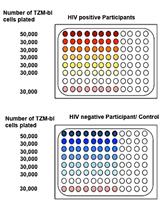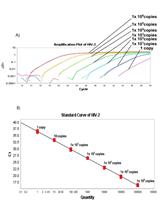- Submit a Protocol
- Receive Our Alerts
- EN
- EN - English
- CN - 中文
- Protocols
- Articles and Issues
- For Authors
- About
- Become a Reviewer
- EN - English
- CN - 中文
- Home
- Protocols
- Articles and Issues
- For Authors
- About
- Become a Reviewer
Analysis of Early Phase HIV-1 Replication and Integration Events by Using Real-time PCR
Published: Vol 9, Iss 4, Feb 20, 2019 DOI: 10.21769/BioProtoc.3168 Views: 4810
Reviewed by: Marielle CavroisDaniela BoehmPooja Saxena

Protocol Collections
Comprehensive collections of detailed, peer-reviewed protocols focusing on specific topics
Related protocols

TZA, a Sensitive Reporter Cell-based Assay to Accurately and Rapidly Quantify Inducible, Replication-competent Latent HIV-1 from Resting CD4+ T Cells
Anwesha Sanyal [...] Phalguni Gupta
May 20, 2019 6511 Views

Quantification of HIV-2 DNA in Whole Blood
Zsófia Szojka [...] Patrik Medstrand
Oct 20, 2019 4476 Views

Generation and Implementation of Reporter BHK-21 Cells for Live Imaging of Flavivirus Infection
Jorge L. Arias-Arias and Rodrigo Mora-Rodríguez
Mar 5, 2021 2535 Views
Abstract
Upon entry into a host cell, the HIV-1 virus undergoes a series of critical early replication events including reverse transcription, nuclear import, and integration of its cDNA into the host genome. Molecular assays used to detect and analyze changes in HIV-1 early phase replication events are valuable tools in developing potential antiretroviral drugs, as well as studying the pathogenesis of HIV. Described here are the molecular assays utilized to detect and quantify HIV-1 early, intermediate, and late reverse transcription (RT) products. In addition to this, protocols for quantifying HIV-1 2-LTR circle DNA and proviral DNA after integration are also included. In these protocols, the optimized TaqMan Real-time PCR reagent is used to increase assay sensitivity and reproducibility. Furthermore, a nested PCR is applied to HIV-1 integration quantification with increased accuracy.
Keywords: HIV-1Background
After binding to the receptor and fusing to the host cell’s lipid bilayers, the HIV-1 nucleoprotein complex first enters the cytoplasm, crosses the nuclear envelope, and finally integrates the reverse-transcribed HIV genome into that of the host cell. During this early phase of replication, HIV-1 converts its single-stranded RNA genome into linear double-stranded DNA in cytoplasm by an intricate reverse transcription process (Hu and Hughes, 2012). After nuclear import, some of these linear viral genomes are integrated into the host chromatin. These are termed proviruses. The remaining cDNA that fails to integrate is circularized into either 1-LTR circle DNA or 2-LTR circle DNAs (Sloan and Wainberg, 2011). HIV-1 can counteract various host restriction factors that can interfere with its early phase replication events (Zheng et al., 2012). Molecular assays used to detect and analyze changes in HIV-1 early phase replication events are valuable tools in studying HIV pathogenesis and in developing potential antiretroviral drugs. We report here methods to quantitatively analyze several critical events during HIV-1 early phase replication by using Real-time PCR. The early, intermediate and late stages of reverse transcription events are represented by the initiation of HIV-1 minus strand DNA synthesis, the elongation of minus-strand DNA synthesis following transfer of minus strand DNA, and the synthesis of complete double-stranded linear viral DNA after plus-strand DNA transfer respectively. Given that 2-LTR circles are exclusively found in the cell nucleus, they have become a useful marker of viral nuclear import (Sloan and Wainberg, 2011). As shown in Figure 1, a nested PCR is utilized to quantify HIV-1 integration with increased sensitivity and specificity. Since Alu sequences are the most abundant repetitive DNA, containing over one million copies dispersed throughout the human genome, the 1st round of PCR is designed to amplify a fragment between the integrated HIV-1 gag gene and the host genomic Alu sequence element. Both forward and reverse Alu PCR primers are used in 1st round Alu-gag PCR, since either orientation of Alu sequence can exist in human genome. To avoid the amplification of unintegrated HIV-1 cDNA, the 5’ end of 1st PCR gag R primer is tagged with a unique R sequence. Only the 1st round PCR amplicons containing the R sequence can be used as templates in the 2nd round of Real-time PCR. The optimized TaqMan Real-time PCR reagent is used to increase assay sensitivity and reproducibility. All PCR primers, probe sequences, and their amplicon locations are listed in Table 1.
Figure 1. A nested PCR for quantification of HIV-1 integration
Table 1. A list of sequences of PCR primers and probes
Materials and Reagents
- Axygen® MicroVolume Extended-Length Filtered Pipet Tips (Axygen, catalog number: TXLF10)
- Axygen® Universal Fit 100 µl Filtered Pipet Tips (Axygen, catalog number: TF100RS)
- Axygen® Universal Fit 200 µl Filtered Pipet Tips (Axygen, catalog number: TF200RS)
- Axygen® Universal Fit 1,000 µl Filtered Pipet Tips (Axygen, catalog number: TF1000LRS)
- Axygen 1.5 ml Snaplock Microtubes (Axygen, catalog number: MCT150CS)
- 10 cm cell culture dish (Celltreat, catalog number: 229621)
- 24-well plate (Celltreat, catalog number: 229123)
- MicroAmp Fast Optical 96-well Reaction Plate (Thermo Fisher, catalog number: 4346907)
- MicroAmp Optical Adhesive Film (Thermo Fisher, catalog number: 4311971)
- 0.45-μm-pore-size filters (Thermo Fisher, catalog number: EMD MilliporeTM SLHV033RS)
- Ach2 cells (NIH AIDS Reagent Program, catalog number: 349)
- HEK-293 Cells (NIH AIDS Reagent Program, catalog number: 103)
- Opti-MEMTM (Thermo Fisher, catalog number: 31985062)
- X-tremeGENE 9 DNA Transfection Reagent (Sigma, catalog number: 6365779001)
- The vesicular stomatitis virus G protein (VSV-G) expression vector pVSV-G (Clontech Laboratories, catalog number: 631530)
- HIV-1 plasmids pNL4-3 env(-)nef(-)gfp(+) (a gift from Dr. Vicente Planelles)
- DNeasy Blood & Tissue Kit (QIAGEN, catalog number: 69506)
- TaqManTM Universal PCR Master Mix (Thermo Fisher, catalog number: 4324018)
- TaqMan Fast Advanced Master Mix (Thermo Fisher, catalog number: 4444557)
- Platinum Taq DNA polymerase (Thermo Fisher, catalog number: 10966026)
- Custom PCR primers and TaqMan probes, HPLC purified (Integrated DNA Technologies)
- Turbo DNase (2 U/µl) (Thermo Fisher, catalog number: AM2238)
- Dulbecco’s Phosphate Buffered Saline (PBS) (Sigma, catalog number: D8537)
- 10% Fetal Bovine Serum (FBS) (Gibco, catalog number: 10438026)
- Penicillin-Streptomycin (Gibco, catalog number: 15070063)
- Dulbecco’s Modified Eagle’s Medium (DMEM) (Sigma, catalog number: D6171)
- Absolute Ethanol (200 proof) (Fisher Scientific, catalog number: BP2818100)
- Water (Sigma, catalog number: W4502)
- MgCl2 (Thermo Fisher, catalog number: 10966026) (It comes in with the Platinum Taq DNA polymerase)
Equipment
- 0.5-10 µl Eppendorf Research® plus Adjustable Volume Pipettes (Eppendorf, catalog number: 3123000020)
- 10-100 µl Eppendorf Research® plus Adjustable Volume Pipettes (Eppendorf, catalog number: 3123000047)
- 20-200 µl Eppendorf Research® plus Adjustable Volume Pipettes (Eppendorf, catalog number: 3123000055)
- 100-1,000 µl Eppendorf Research® plus Adjustable Volume Pipettes (Eppendorf, catalog number: 3123000063)
- Revco Laboratory CO2 Incubator Ultima II (Thermo Fisher, catalog number: RCO3000T9V)
- Vortex-Genie 2 Vortex Mixer 12 (Scientific Industries, catalog number: 12-812)
- NanoDropTM 2000 Spectrophotometer (Thermo Fisher, model: NanoDropTM 2000, catalog number: ND-2000)
- StepOnePlusTM Real-Time PCR System (Thermo Fisher, catalog number: 4376600)
- Veriti® 96-Well Thermal Cycler (Thermo Fisher, catalog number: 4375786)
- Eppendorf Centrifuge 5430R (Eppendorf, model: 5430R)
- Eppendorf Centrifuge 5424R (Eppendorf, model: 5424R)
Software
- StepOne software v2.2.2 (Thermo Fisher)
Procedure
- VSV-G pseudotyped virus preparation and host cell infection
- Culture 4 x 106 HEK293 cells in DMEM with 10% FBS and 100 units/ml of penicillin and 100 µg/ml of streptomycin in a 10 cm cell culture dish at 37 °C, 5% CO2 overnight.
- In a 1.5 ml Eppendorf tube, add 500 µl of Opti-MEMTM, and 25 µl of X-tremeGENE 9 DNA Transfection Reagent (Roche), mix well by pipetting up and down gently, add 3 µg of HIV-1 plasmids pNL4-3 env(-)nef(-)gfp(+) and 2 µg of pVSV-G, mix gently by pipetting up and down. Leave at room temperature for 30 min. Add to the cultured HEK293 cells drop by drop, and gently shake or swirl the dish to ensure distribution over the entire dish surface.
- After 24 h, wash the transfected HEK293 cells with PBS, and then replace it with 10 ml fresh DMEM complete media.
- After 48 h of transfection, harvest the supernatant containing pseudotyped viruses and pass through 0.45-μm-pore-size filters. The virus containing supernatant is then aliquoted and stored at -80 °C.
- Treat the prepared virus with 20 U/ml Turbo DNase at 37 °C for 1 h before infection.
- Prepare 0.5-0.75 x 106 cells/well host cells for infection experiment in a 24-well plate. Differentiated human macrophages and THP1 cells, cultured adherent cell lines such as HCT116 are all suitable to be used as host cells. Add 100 µl virus per well to cultured cells. After cells are infected for 2 h in the 37 °C incubator, remove virus containing culture media, and replace it with fresh media.
- At post infection time points as designed by experiment, remove culture media, and wash once with 0.5 ml PBS. Discard all remaining PBS.
- Extraction of total cellular DNA by using the DNeasy Blood & Tissue Kit (QIAGEN)
- To each well, add 200 μl PBS, 20 µl Protease K and then 200 µl Buffer AL. Mix thoroughly. Incubate the plate at 37 °C for 5 min to lyse cells.
- Transfer cell lysate into a 1.5 ml Eppendorf tube. Incubate at 56 °C for 10 min.
- Add 200 µl of 100% Ethanol to each sample, and mix thoroughly with a vortex mixer.
- Pipet the mixture into the DNeasy Mini spin column placed into a 2 ml collection tube. Centrifuge at 6,000 x g for 1 min, using an Eppendorf Centrifuge 5424R. Discard flow-through and collection tube.
- Place the DNeasy Mini spin column into a new 2 ml collection tube, add 500 μl Buffer AW1, and centrifuge for 1 min at 6,000 x g, using an Eppendorf Centrifuge 5424R. Discard flow-through and collection tube.
- Place the DNeasy Mini spin column into a new 2 ml collection tube, add 500 μl Buffer AW2, and centrifuge for 3 min at 20,000 x g, using an Eppendorf Centrifuge 5424R. Discard flow-through and collection tube.
- Place the DNeasy Mini spin column into a clean 1.5 ml microcentrifuge tube, and pipet 100 μl Buffer AE directly onto the DNeasy membrane without touching the tip to the membrane. Incubate at room temperature for 5 min, and then use an Eppendorf Centrifuge 5424R to centrifuge for 1 min at 6,000 x g to elute DNA.
- Quantify DNA sample with a NanoDrop or similar device. Dilute DNA sample to 20 ng/µl.
- Quantification of HIV-1 reverse transcription products quantification
- Prepare the reaction mix for each sample as follows: 1 µl each of forward and reverse primers (10 µM), 1 µl of TaqMan probe (5 µM), 5 µl of DNA sample, 2 µl of H2O, and 10 µl TaqMan® Universal PCR Master Mix (2x).
- Calculate the volume of each component of the PCR reaction mix by multiplying the volume of each component by the number of replicates for each sample. Make a PCR master mix without sample DNA and prepare 110% of the required volume to account for pipetting error.
- Pipet 15 µl of PCR master mix to each reaction well, and add 5 µl of sample DNA (20 ng/µl). Seal the PCR Plate with film, and centrifuge it at 2,200 x g for 30 s, using an Eppendorf Centrifuge 5430R.
- Perform PCR on a StepOnePlusTM Real-Time PCR System using the following program: 95 °C 2 min preheat, then 40 cycles of 95 °C for 15 s and 60 °C for 1 min.
- When running a PCR that is quantifying HIV-1 early, intermediate, late reverse transcription products, as well as 2-LTR cycle DNA, it is necessary to use the GAPDH gene as a reference. In addition to this, the Real-time PCR should be carried out in parallel with target gene amplification.
- Use Real-time PCR relative quantification ∆∆Ct method to calculate sample target gene copy numbers.
- HIV-1 integration quantification
- DNA from Ach2 cells, which have a single copy HIV genome integration, is used as a copy number control. 3.59 µg of genomic DNA contains about 106 genome copies. Serially diluted DNA standards from 1 x 104 to 1 copies/µl (it is actually 1 copy) (20 ng DNA) are prepared by mixing DNA from Ach2 cells with DNA from uninfected human cells in corresponding proportions.
- In the 1st integration PCR, prepare a reaction with the following components: 2.5 µl 10x buffer, 0.75 µl 50 mM MgCl2, 0.5 μl 10 mM dNTP, 0.5 µl of each forward and reverse Alu primers (10 µM), 0.5 µl reverse primer HIV-1 gag-R (10 µM), 0.5 U of Platinum Taq DNA polymerase (Thermo Fisher), 5 µl sample DNA (100 ng), add H2O to total 25 µl. Perform PCR using a Veriti® 96-Well Thermal Cycler (Thermo Fisher) with the following program: preheat to 94 °C for 2 min, then run 15 cycles of 94 °C for 30 s, 55 °C for 30 s, 72 °C for 3 min. Hold the samples at 72 °C for additional 5 min.
- For the 2nd round of Real-time PCR for integration quantification, prepare the reaction mix for each sample as follows: 1 µl each of forward and reverse primers (10 µM), 1 µl of TaqMan probe (5 µM), 5 µl of 10-fold diluted 1st round PCR product, 2 µl of H2O, and 10 µl TaqMan® Universal PCR Master Mix (2x).
- Perform PCR with StepOnePlustTM Real-time PCR System using the following program: Preheat to 95 °C for 2 min, then 40 cycles of 95 °C for 15 s, and 60 °C for 1 min.
- Use the Real-time PCR standard curve method to determine sample target gene copy numbers.
- Representative experiments can be found in Figure 2 of paper by Shi et al. (2018) and Figure 7 of paper by Furuya et al. (2016).
Notes
- The PCR primers and TaqMan probes are designed based on HIV-1 sequence of pNL4-3. Please check sequence alignment if other strains of HIV-1 viruses are used.
- If uses HIV-1 isolates or lab strains, DNase treatment is not necessary.
- Another Real-time PCR reagent, TaqMan Fast Advanced Master Mix (Thermo Fisher), has provided results similar to TaqMan® Universal PCR Master Mix (Thermo Fisher).
Acknowledgments
This study was supported by the Scholarship of Discovery Intramural Research Grant to Dr. Binshan Shi by Albany College of Pharmacy and Health Sciences; Protocols described here were adapted from protocols from previous publications by Butler et al., 2001; Yamamoto et al., 2006; Mbisa et al., 2009.
Competing interests
All authors declare no conflicts of interest or competing interests.
References
- Hu, W. S. and Hughes, S. H. (2012). HIV-1 reverse transcription. Cold Spring Harb Perspect Med 2(10).
- Sloan, R. D. and Wainberg, M. A. (2011). The role of unintegrated DNA in HIV infection. Retrovirology 8(1): 52.
- Zheng, Y. H., Jeang, K. T. and Tokunaga, K. (2012). Host restriction factors in retroviral infection: promises in virus-host interaction. Retrovirology 9: 112.
- Shi, B., Sharifi, H. J., DiGrigoli, S., Kinnetz, M., Mellon, K., Hu, W. and de Noronha, C. M. C. (2018). Inhibition of HIV early replication by the p53 and its downstream gene p21. Virol J 15(1): 53.
- Furuya, A. K., Sharifi, H. J., Jellinger, R. M., Cristofano, P., Shi, B. and de Noronha, C. M. (2016). Sulforaphane inhibits HIV Infection of macrophages through Nrf2. PLoS Pathog 12(4): e1005581.
- Butler, S. L., Hansen, M. S. T. and Bushman, F. D. (2001). A quantitative assay for HIV DNA integration in vivo. Nature Medicine 7: 631.
- Yamamoto, N., Tanaka, C., Wu, Y., Chang, M. O., Inagaki, Y., Saito, Y., Naito, T., Ogasawara, H., Sekigawa, I. and Hayashida, Y. (2006). Analysis of human immunodeficiency virus type 1 integration by using a specific, sensitive and quantitative assay based on Real-time polymerase chain reaction. Virus Genes 32(1): 105-113.
- Mbisa, J. L., Delviks-Frankenberry, K. A., Thomas, J. A., Gorelick, R. J. and Pathak, V. K. (2009). Real-time PCR analysis of HIV-1 replication post-entry events. Methods Mol Biol 485: 55-72.
Article Information
Publication history
Accepted: Jan 8, 2019
Published: Feb 20, 2019
Copyright
© 2019 The Authors; exclusive licensee Bio-protocol LLC.
How to cite
Graf, L., Moran, S. P., Ro, S., de Noronha, C. M. and Shi, B. (2019). Analysis of Early Phase HIV-1 Replication and Integration Events by Using Real-time PCR. Bio-protocol 9(4): e3168. DOI: 10.21769/BioProtoc.3168.
Category
Microbiology > Microbial cell biology > Cell-based analysis
Molecular Biology > DNA > DNA quantification
Do you have any questions about this protocol?
Post your question to gather feedback from the community. We will also invite the authors of this article to respond.
Tips for asking effective questions
+ Description
Write a detailed description. Include all information that will help others answer your question including experimental processes, conditions, and relevant images.
Share
Bluesky
X
Copy link








